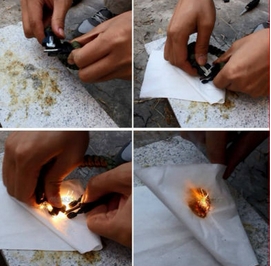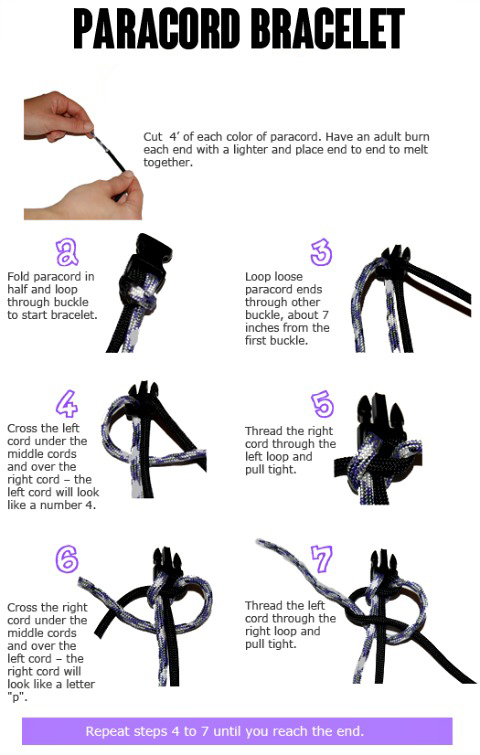Man can live about forty days without food, about three days without water, about eight minutes without air, but only for one second without hope. – Anonymous
Can you provide more details on product components?
Paracord (also parachute cord) is an essential for a stocked bug-out bag and personal survival items supply list. Unraveling the bracelet produces paracord that extends to 11.5-12.5 feet (or 3.5-3.8 meters for 9-in bracelet) and 12.5-13+ feet (3.8-4.0 meters for 10-in bracelet). Its breaking strength is 550 pounds that was used, in fact, by astronauts on a mission to repair the Hubble telescope! It is made strong by a sheath that is made up of 7 Inner cords /strands. So, though you may have up to 13-feet of 550 mil-spec cord, when you break it down to your inner cord, you’re looking at ±90 feet with the outer sheath and inner cord. Then, if you break inner cord down all the way, that would be ±270 feet of that 7-lb to 10-lb test inner cord, which you can do a lot with for that amount of cord. You don’t have to keep it at its 550-lb size to use it but break it down to the size you need for the type of task you want to do. Thus, not only is the cord handy but the yarns inside it are practical for sewing, fishing, and over 100 other uses. Watch this mind-blowing video that shows why this is simply an amazing survival tool.
Fire steel works no matter what the conditions are, even when the temperature drops to -51°C (-60°F) or rises to 150°C (302°F). You can even spark it up when it’s wet or dropped in snow.
Stainless knife / cutter / scraper doubles as a striker to make a spark and start a fire when struck against the fire flint. Fire provides a good source for heat, lighting, protection, and is needed in order to cook and boil water. Striker blade also cuts paracord, does small cutting jobs, and shaves beetle-killed branches for firewood.
Whistle is high-pitched with loudness to 100 decibels. Sound travels better late at night.
Paracord bracelets come in two sizes: 9-in for women or 10-in for men (length) with ≤1-in (height) and ≤0.4-in (width).
All bracelet components are tucked away or attached to a heavy-duty, durable, side-release buckle. All five components are also waterproof, corrosion-free and mildew-resistant.
What makes paracord bracelet extremely vital to have and keep?
In a survival situation, we absolutely need to have these three most important resources: a fire-starting device, cutting tool and some paracord. Then, add to that the extra features of a whistle and compass incorporated into this bracelet.
Fire is life in a survival situation. You can use the stainless cutter-scraper to strike fire flint to start and make fire in ANY condition for heat to keep warm, cooking and boiling water, protection, lighting, etc., thus, covering just about EVERY survival need. With the fire starter, you can also make a signal fire for help. The cutter-scraper, which also doubles as striker-blade, cuts paracord, does small cutting jobs, and shaves beetle-killed branches for firewood. Paracord is one of the most versatile survival tools and useful in a hundred different ways: build shelter/splint, animal snares, lash spear/ rafts, repair equipment, rig sails/pulley system, administer first aid, stitch & more. The whistle serves as a signal device to escape danger and signal location to search and rescue teams, while the compass is for navigation.
This compact, light, comfy, easy-to-disassemble, and wearable EDC emergency toolbox is, thus, an invaluable multi-use device that will keep you always prepared anywhere in any contingencies, and can be a lifesaver at a time you need to use it. To show how beneficial this bracelet is, here are a 101 Uses for Paracord.
Is the bracelet good for everyone? Is it appropriate for children too?
Absolutely, everyone should have one. There are many videos on YouTube.com that show how it works. However, just like surgeons, you can’t expect to perform surgery after watching a video on a heart bypass surgery. It takes time to learn and a lot of practice to acquire a skill at something. Besides, with all the technology available nowadays, people tend to assume they know more than they actually do and, often times, it takes a crisis for some to realize they know very little, if anything at all. Particularly, children must be shown exactly how the different components or features work so they are ready when it’s needed. In view of that, paracord bracelets make a great gift for scouts.
How do I unravel or release the (bracelet) cord?
It is simple to unwind or unravel paracord bracelet in survival situations to perform multiple tasks such as shelter building, splint building, spear lashing, building animal snares and many other tasks.
Look where the ends of the rope had been melted and glued on one end of the bracelet. This appears whitish. Take and move it until you break that plastic free where it melted, and loosen up cord end till it unwraps. Push it back through the loop where it was put through and keep going, breaking it down as you loosen them up. Continue taking it apart all the way down the line until you have one piece of up to 13-ft 550 cord.
How do I start fire?
Fire (or starting one) is the the most basic yet essential survival skill any man, woman or child should have. Particularly, in a survival situation, fire is life. The paracord bracelet you purchased is equipped with a firesteel that allows you to start a fire anytime, anywhere, and no matter what the condition or weather might be. With fire, you can produce an immense amount of heat (over 1445℉ or 785°C!), cook food, clean or boil water, make weapons, and more, thus, covering just about EVERY survival need. So, it’s good to know how to start one by practicing using lint, cotton balls soaked in alcohol or smeared with petroleum jelly, or other materials such as lint, dry tinder, and char cloth.
 To produce a spark, simply scrape striker blade or cutter-knife against / across flint rod or fire steel. To make fire in survival situations, when striking, keep striker almost parallel to the fire steel while using slow, hard movements (friction ignites) toward some lint and dry kindling you want to light. To get the quickest fire, try to cover the rod in what you are trying to light. Even with no tinder or kindling, you could use the inner strands by nesting it up to make a little airy nest as fire-starting kindling.
To produce a spark, simply scrape striker blade or cutter-knife against / across flint rod or fire steel. To make fire in survival situations, when striking, keep striker almost parallel to the fire steel while using slow, hard movements (friction ignites) toward some lint and dry kindling you want to light. To get the quickest fire, try to cover the rod in what you are trying to light. Even with no tinder or kindling, you could use the inner strands by nesting it up to make a little airy nest as fire-starting kindling.
It is advisable to have dry tinder at all times, even carry with you always. Cotton balls, wood shavings, dried grasses/leaves make ideal tinder, and can easily fit in your pack or pocket. Otherwise, you can find fire starters or combustibles everywhere: lint in your pocket, thread from your clothing, or dry tinder from wood. Even alcohol wipes and hand sanitizer (which contains alcohol) can be fire starters when you squeeze an alcohol wipe over dry tinder or place some sanitizer on the tinder. It is so important to be certain that the tools you have will work as intended and that you know how to make them work before getting into a situation. Getting lost or stranded would not be the best time to experiment. It can’t be stressed enough how vital it is to practice your fire starting methods in a controlled environment to gain the skill and self-confidence needed to create fire in any environment. Click here to see a video on how to start a fire indoors and click here to start a fire outdoors.
Does striker-blade slide free to use as cutter? Is there a click mechanism that locks it in place? Won’t it fall off easily in time?
No, there’s no click mechanism in place and current manufacturer has glued the striker-blade in place, which would make it easier (with better grip or hold) to make a spark when struck against the fire steel as well as cut or scrape bark from a tree for tinder. However, if so desired, it could be removed by using pliers.
Why is there a variance in the actual length of bracelet cord?
The bracelets are 100% hand woven and crafted (from military spec 500-lb paracord) by both male and female worker/designers at the plant so each one is unique, and this accounts for why the weave may either be slightly tighter or looser, and the length may vary anywhere between 0.1 – 0.2 meter.
How do I clean and care for my bracelet?
Wash with soap and water. You can also put it in the washing machine but not in the dryer. Allow it to air dry.
After using the rope, how do I weave it back in bracelet form?
To braid it back in “Cobra Style”, please click here.
How do I make my own survival bracelet?
How to weave it back tightly?

How does warranty apply?
GemstarSurvival® offers a one-year warranty against defects in materials and workmanship from the date of receipt. A defect is defined as any fault in the product’s materials or workmanship that is present at the time of receipt. Hence, this warranty does not cover accidental damage, normal wear and tear or normal aging of the product, negligent use, willful abuse, intentional acts to damage the product, mishandling or improper usage, damage caused by modifications, and misrepresentation or fraudulent claims.
The GemstarSurvival ® Warranty is non-transferable. Purchasing a GemstarSurvival® product from unauthorized resellers or online auction websites will void and make the purchased product ineligible for warranty protection.
We strive to offer you our best products and service, but if there is any defect component of the bracelet or any pressing issue with your purchase, please contact Amazon’s friendly and courteous Customer Service with problem description before returning a damaged item. Amazon will determine whether to send a replacement or issue a refund.
Do you need reviewers?
Yes, we offer special deals to reviewers. If you have a YouTube channel, blog, or other form of gear reviewing or testing venue, then contact us for details.
What is EDC and what does it stand for?
Everyday carry (EDC) or every day carry refers to a small collection of tools, equipment and supplies that are carried on a daily basis to assist in tackling situations ranging from the mundane to the disastrous.
Any more questions? Require more information?
Please contact us if you have any other issues, questions, and concerns.
A Prepper’s Dictionary
Bugging Out – leaving your current position and moving to a safer location.
Bugging In – hunkering down, staying at your location until it is safer to bug out!
Bug-Out Bag (aka BOB and 72-hour bags) – A bug out bag is backpack or other style bag (I.e. duffle bag) that contains all of the necessities you would need to survive after a disaster. Your BOB allows you to take what you need with you quickly and evacuate should a disaster occur. Most people keep enough gear to last 72 hours, but since most disasters can disrupt services for longer than 72 hrs, I think it’s a good idea to have a bag that will allow you to survive indefinitely. Common items to carry include MRE’s, protein bars, fire starters, first aid kit, water, water filters, maps, cash, firearms, ammo, sleeping bags, emergency medicine, shelter (tent, poncho, tarp), clothing, fishing kit, snares and copies of personal identification (photos of passports, drivers licenses, social security card, etc.).
EDC – Everyday carry or what a person caries on them on a daily basis.
Multi-tool – This is a combination of a survival knife and a wide assortment of other tools (pliers, saw, wire cutters are some examples).
Prep – This is slang for prepare.
Prepper – A prepared individual, a survivalist, self-reliant without substantial assistance from outside resources (government, police, etc.).
Preps – This is slang for preparations.
SHTF – Sh*t hits the Fan. This means that some kind of catastrophic event has happened. (natural disaster, financial collapse, terrorist attack)
Source: Prepper Urban Dictionary http://prepforshtf.com/prepper-urban-dictionary

